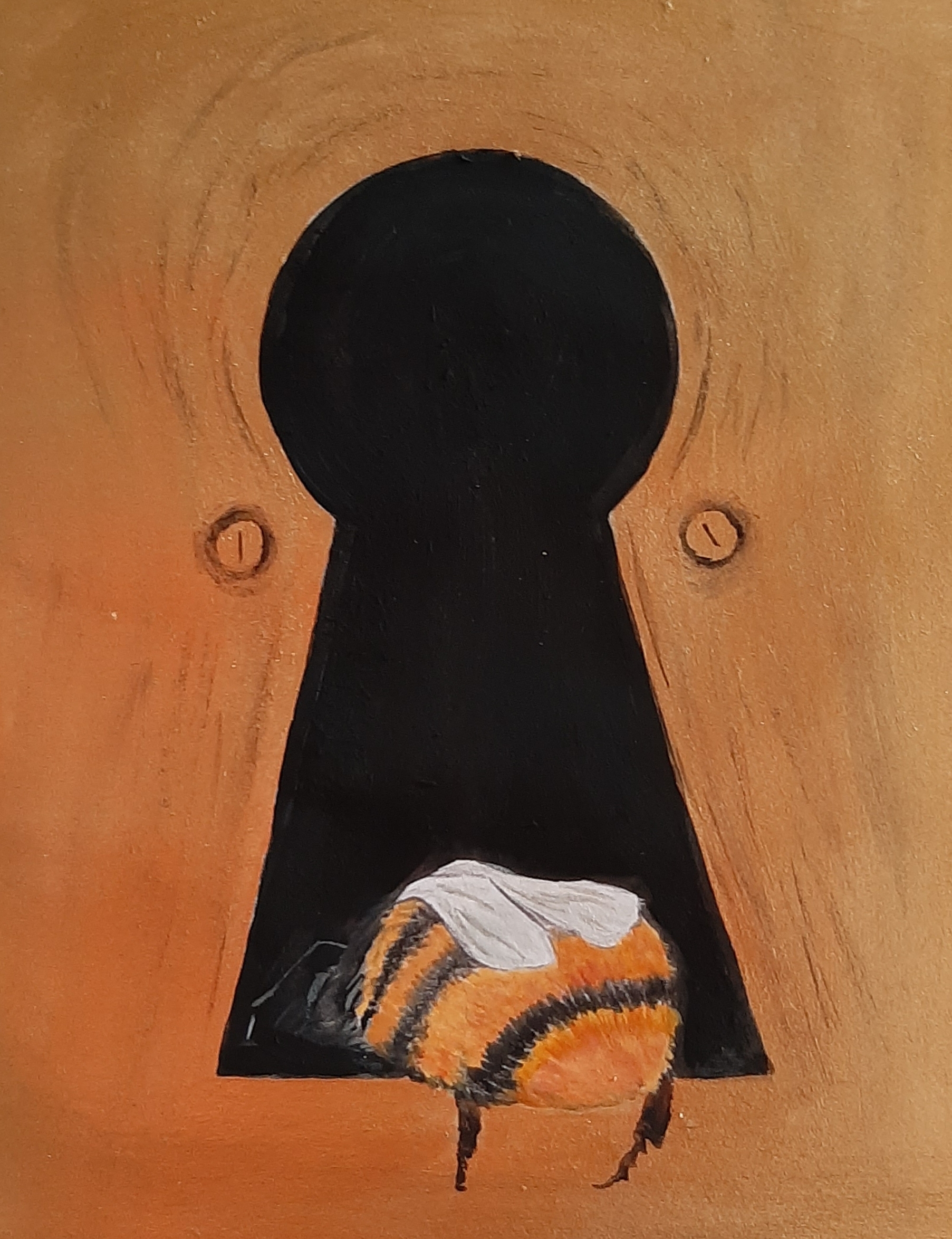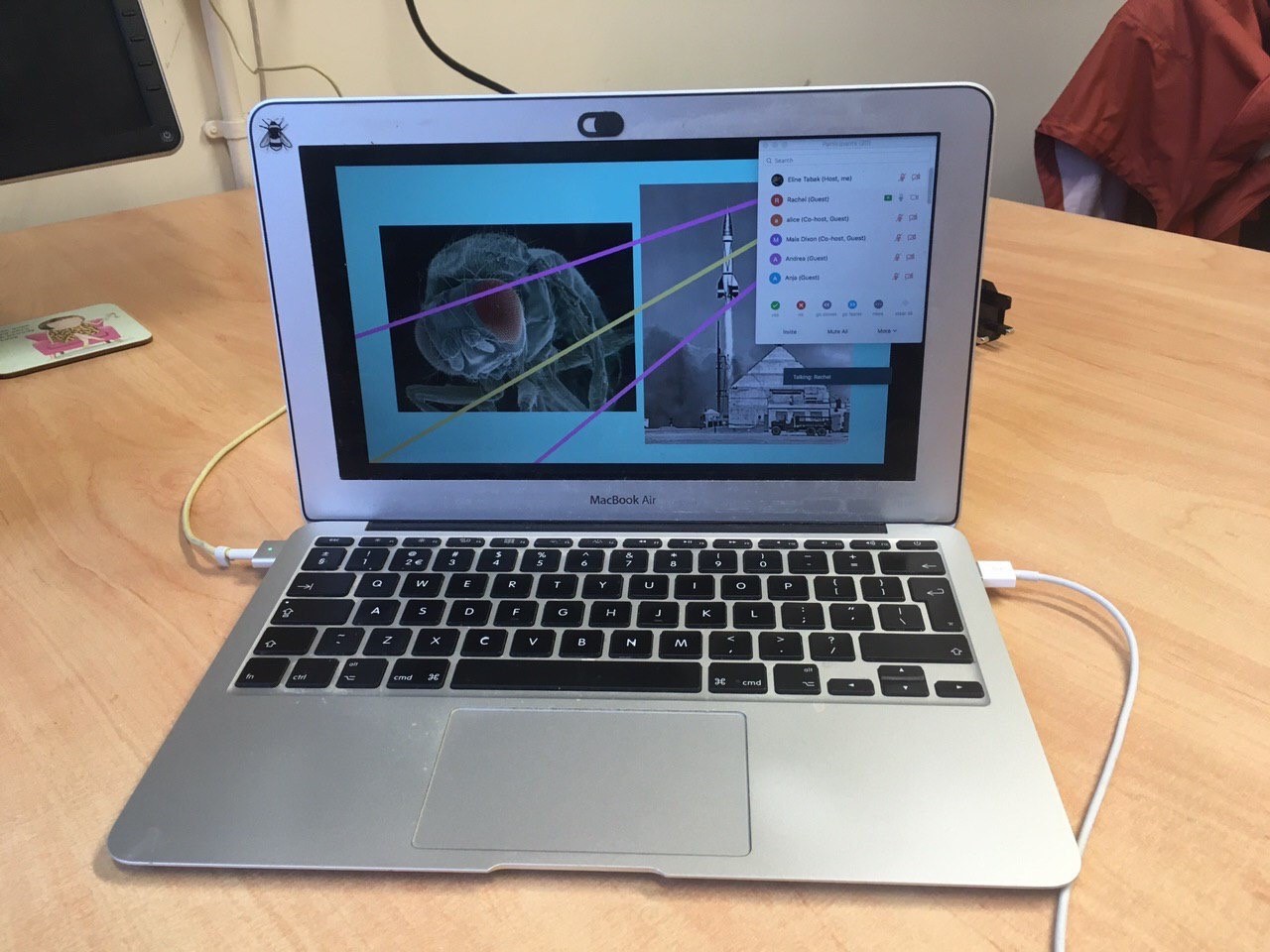by Rosamund Portus
The door to my house is much more than it appears. It is, I think, a well-known hotel amongst the bee population of York.
Allow me to explain.
One hot June day, during the very first summer I was living in my house, I was rushing out the door when I had a surprise encounter. Turning round to push on the door, satisfying myself that it really was locked, I was shocked—and delighted—to see a reddish-brown bee flying directly into the old, unused keyhole situated near the bottom of the door. The keyhole, which has been neglected in favour of the shiny new Yale lock at the top of the door, was evidently a perfect nesting spot. As I stood there, captivated by the idea that a bee was inside my door, another small bee followed suit. Finding the hole occupied, this second bee shimmied back out and took flight in search of a different nest.
This encounter genuinely thrilled me. Despite my impending appointment I spent some minutes trying—and failing—to capture a photo of the bee. Even more delightfully, in the coming weeks I spotted the bee—which I later identified as a red mason bee—a number of times. Of course, as June moved into July this little bee disappeared. A quick internet search of a red mason bee life-cycle followed, and I figured the bee was probably no more.

You can imagine the delight I felt when, around twelve months later, a bee flew out of the very same unused keyhole. This bee, which was a beautiful gold colour, similarly spent the next six weeks or so making the odd appearance before once again completely disappearing.
This year marks my third summer living in this house. It is also—wonderfully—the third summer I have seen a bee come and find shelter in my door. It seems that year after year this small opening in my door provides the perfect bee hotel.
Observing bees living inside my door is nothing but wonderful. For me, it is a reminder that even in an environment designed wholly for human activity other forms of life find a way of being and living. Yet, my utter joy at my door doubling as a bee hotel also reveals my internal bias in how I respond to the presence of nonhuman species. To elaborate, when a wasp enters my house I will go tense, carefully shutting it in a room with the window open and praying it finds its way out before I re-enter. Similarly, I remember feeling far from delighted when a flurry of mosquitos found their way into the room of a Spanish guesthouse I was due to spend a fortnight. And whenever I am confronted with an eight-legged, eight-eyed friend I will watch from a (very) safe distance whilst my partner uses paper and a glass to remove it from the house.
Over the course of my studies into human-animal relations, I have learnt to appreciate and respect those many other invertebrates and, of course, arthropods which find themselves unwitting guests in our homes. This is, however, a care which I have had to actively cultivate. Bees, on the other hand, have long been knitted into my imagination as fundamentally good. The reasons for my—and many others—association between bees and goodness are myriad: they are rooted in the pleasure of honey, the sweet smell of beeswax, the appeal of flowers, the knowledge of our reliance on pollinated crops, and our willingness to aesthetically appreciate their fluffy bodies. Our tangible entanglements with bees have further facilitated their presence in our stories, traditions, languages, and artworks (Maeterlinck, 1901; Ransome, 1937; Wilson, 2004; Hanson, 2018). Of course, whilst predominantly honeybees sting when threatened, many associate all bee species with the painful feeling of being stung. And yet, as bees become increasingly known as species haunted by the possibility of extinction, they have more and more become creatures of empathy in the public eye (Moore and Kosut, 2013).
Thinking through my response to the bees that have made nests in my front door, I came to consider how our everyday reactions to species have consequences that extend far beyond whether a creature might be squished, admired, or given a wide berth. In the current era of rapid biodiversity change and loss, the values and understandings associated with different species intertwine with wider processes of care, responsibility, and protection. As literature across the environmental humanities is increasingly unearthing, public perceptions of different forms of life become a matter of life and death (see van Dooren and Rose, 2011; van Dooren, 2011; O’Gorman, 2014; Clark, 2015). In the case of bees—a species that has become intertwined with fears of decline—our affection for them has ignited a global campaign for their survival. Bee species have become a focus for ecological care, responsibility, and action (Moore and Kosut, 2013).
However, the public perception of a species can also detract from possibilities for care and protection. Take, for example, the wasp. Wasps, the species from which bees evolved, are battling increasing stressors in the modern day (Heffernan, 2017). Yet, as Sumner et al. (2015) make clear, wasps are universally disliked: they are demonised as stinging, aggressive, and vicious creatures. This typical intolerance for wasps not only dampens support for conservational efforts towards protecting wasps, but it is also broadly accepted as the justification for the removal and eradication of wasp nests. Thus, our internal biases, fuelled by specific historical and cultural contexts, have implications which transcend beyond our interactions with individual life-forms, and influence wider conservational choices, actions, and possibilities.
In questioning and thinking through our internal biases, we are presented with opportunities to overcome them. This is not to say we need to seek out interactions with species we find intimidating in some way. I, for one, am under no illusion as to how much fear I still feel when a wasp comes close to me. Rather, it is to suggest that if we—by which I mean anyone who has the interest to—can work to positively shift narratives surrounding species which are typically unloved or undesired, we can open up new possibilities for the flourishing of lives that are too often easily eradicated or dismissed. For whilst we might hope for a future filled with bees, we also need a future that is alive with the many other species—wasps, spiders, slugs, worms, or rats—which are equally as valuable for both sustaining and nurturing new forms of biodiversity, and yet whose presence seldom brings the same easy delight as the presence of a bee.
—
Clark, J.L. 2015. Uncharismatic Invasives. Environmental Humanities. 6(1), 29-52. DOI:10.1215/22011919-3615889.
Hanson, T. 2018. Buzz: The Nature and Necessity of Bees. Basic Books.
Heffernan, O. 2017. Steep decline of wasps and other flying nasties is a bad sign. [Online]. New Scientist. Last updated: 19 October 2017. Available at: https://www.newscientist.com/article/2150977-steep-decline-of-wasps-and-other-flying-nasties-is-a-bad-sign/ [Accessed 20 July 2020].
Maeterlinck, M. 1901. The Life of the Bee. George Allen.
Moore, L.J. and M. Kosut. 2013. Buzz: Urban Beekeeping and the Power of the Bee. New York UP.
O’Gorman, E. 2014. Belonging. Environmental Humanities. 5(1), 283–286. DOI: 10.1215/22011919-3615523.
Ransome, H.M. 1937. The Sacred Bee in Ancient Times and Folklore. George Allen & Unwin.
Sumner, S., G. Law, and A. Cini. 2018. Why we love bees and hate wasps. Ecological Entomology. 43(6), 836–845. DOI: 10.1111/een.12676.
van Dooren, T. 2011. Invasive species in penguin worlds: An ethical taxonomy of killing for conservation. Conservation & Society. 9(4), 286-298.
van Dooren, T. and D.B. Rose. 2011. Introduction. Australian Humanities Review. 50, 1-4.
Wilson, B. 2004. The Hive: The Story of the Honeybee and Us. Thomas Dunne Book.



